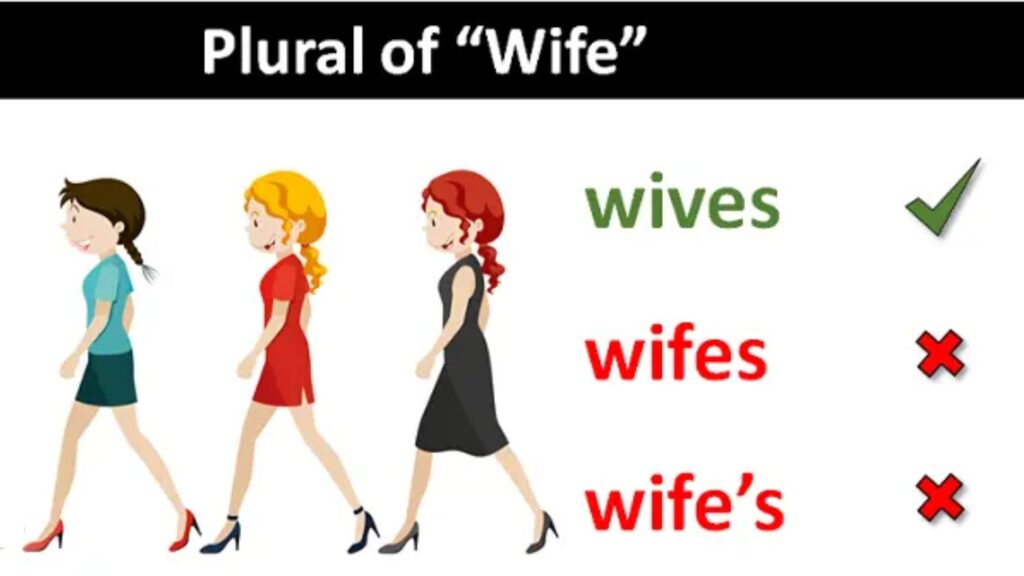If you’ve ever paused mid-sentence wondering, “What’s the correct plural of wife?”, you’re not alone. English is full of irregular plural nouns that defy simple patterns, and “wife” is a prime example. While some might mistakenly say “wifees” or hesitate between “wife plural word” options, the truth is straightforward: the correct plural of wife is wives.
This article breaks down the plural of wife with English grammar rules, practical examples, and even real-world usage scenarios (like email excerpts) to help you master it confidently.
Understanding the Plural of Wife: Wives is Correct

The plural form of wife is wives, following an irregular pluralization pattern in English where words ending in f or fe often change to ves.
For example:
- Knife → Knives
- Life → Lives
- Wolf → Wolves
This shift comes from Old English pluralization rules where phonetic ease drove pronunciation changes. Over centuries, this linguistic heritage shaped modern pluralization, making “wives” the only correct choice.
Email Scenario Example: Using “Wives” Correctly
Subject: Dinner Invite for Our Wives
Hi Jason,
Looking forward to Friday! Sarah suggested we bring our wives along so everyone can catch up. Does that work for you?Cheers,
Daniel
Here, “wives” flows naturally in casual, friendly correspondence.
Why Not “Wifees” or “Wifes”?
A common mistake is forming the plural as “wifees” or “wifes,” but both are grammatically incorrect. English plural rules don’t support simply adding -s for words ending in f/fe when the consonant sound changes.
Think of this pattern:
- Leaf → Leaves
- Shelf → Shelves
The same applies here: wife becomes wives no extra vowels needed.
Scenario Example: Clarifying in Writing
Subject: Quick Grammar Check
Hey Megan,
Is it “our wifees” or “our wives” in this context? I keep mixing it up!Thanks,
Liam
Reply:
Hi Liam,
It’s definitely “our wives.” Remember, it’s an irregular plural, similar to “knife → knives.”
Such exchanges highlight common grammar mistakes and how to fix them.
Irregular Plural Nouns: Why “Wife” Fits the Pattern
English has several irregular plural nouns that don’t follow the add-an-s rule. Words ending in f or fe typically replace that ending with ves in their plural forms.
Examples:
- Life → Lives
- Wife → Wives
- Knife → Knives
However, not all f-ending words follow this. For example, “roof” becomes “roofs,” not “rooves.” This is where phonetics in pluralization come into play: historical pronunciation shifts shaped which words changed to ves and which didn’t.
Scenario Example: Teaching Context
Imagine you’re tutoring a student named Priya:
“Think of it like this: if the word ends in f/fe and sounds natural as ves (like ‘wife’ to ‘wives’), use it. If it sounds awkward, like ‘roof’ to ‘rooves,’ just add -s.”
This distinction boosts grammatical confidence and fluency quickly.
The Linguistic Heritage of “Wives”
The plural of wife traces back to Old English, where “wif” referred to a woman or spouse. Over time, linguistic shifts changed both spelling and pronunciation, evolving into today’s wives.
This isn’t just grammar trivia it’s proof of historical language evolution and how words mirror cultural history. Even the pronunciation of wives reflects phonetic changes designed to make speech smoother.
Historical Insight Example
A professor might explain:
“In Old English, plural forms often mutated vowels or endings. ‘Wif’ naturally transitioned to ‘wives,’ mirroring other patterns like ‘wolf → wolves.’ It’s a fascinating glimpse into our linguistic heritage.”
Common Mistakes to Avoid
Here’s what to steer clear of:
- ❌ “Wifees” (incorrect invented form)
- ❌ “Wifes” (ignores irregular rule)
- ❌ Overusing “wife” instead of pluralizing in professional contexts
Scenario Example: Workplace Slip
Email Draft:
“Our company picnic welcomes all employees and their wife.”✅ Corrected Version:
“Our company picnic welcomes all employees and their wives.”
Such errors affect grammar in professional writing, weakening clarity.
Professional vs. Casual Language Usage

Knowing the wife plural form matters both in formal writing and casual conversations. In professional contexts (emails, announcements), accuracy builds credibility. In casual chats or social invites, it helps avoid awkwardness.
Professional Email Example
Subject: Family Accommodation Details
Dear Team,
Please confirm if your wives and children will attend the company retreat so we can book family rooms accordingly.
Here, proper pluralization supports effective communication.
Phonetics in Pluralization
The switch from wife to wives isn’t just about spelling; it’s about sound. The f/fe to ves rule softens the consonant cluster, making it easier to pronounce. The same principle applies to knife → knives or life → lives.
Teaching Tip
In phonetics training, emphasize how “wives” glides naturally off the tongue, unlike a hypothetical “wifees,” which feels clunky.
Grammar Practice Tips
To reinforce correct usage:
- Write sentences using wives in different contexts.
- Compare with similar irregular plurals (like life/lives).
- Say them aloud to practice pronunciation.
Quick Practice Example
“My friends and their wives joined us for dinner.”
“The wives discussed their travel plans while we set up the grill.”
Quick Reference Table
| Singular | Plural | Rule Applied |
|---|---|---|
| Wife | Wives | f/fe → ves change |
| Knife | Knives | f/fe → ves change |
| Life | Lives | f/fe → ves change |
| Wolf | Wolves | f → ves change |
| Roof | Roofs | Exception: add -s only |
Final Thoughts: Mastering the Plural of Wife
The plural of wife is wives, and understanding this simple yet irregular pluralization pattern is key for clarity in communication. Whether you’re writing an email, teaching English, or chatting casually, getting it right showcases your mastery of English grammar nuances.
When in doubt, remember: if it follows the f/fe to ves rule (like knife → knives), you’re safe with wives.

